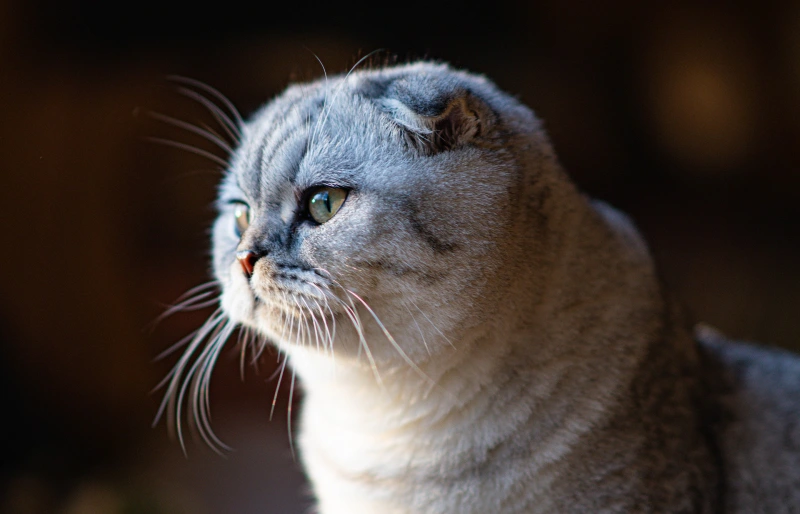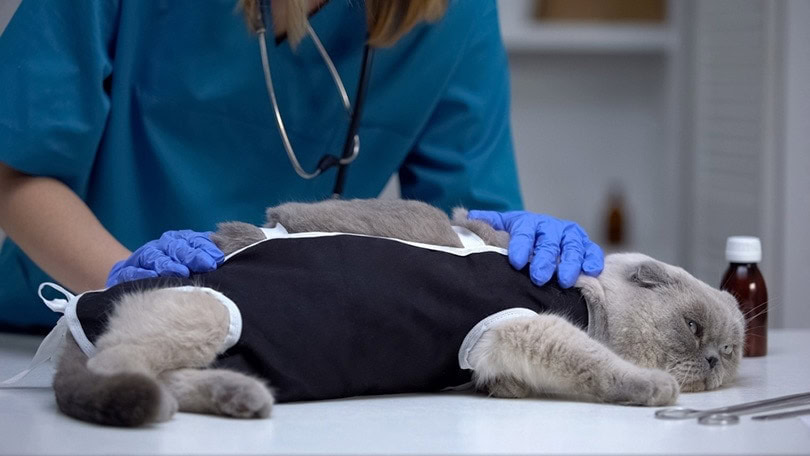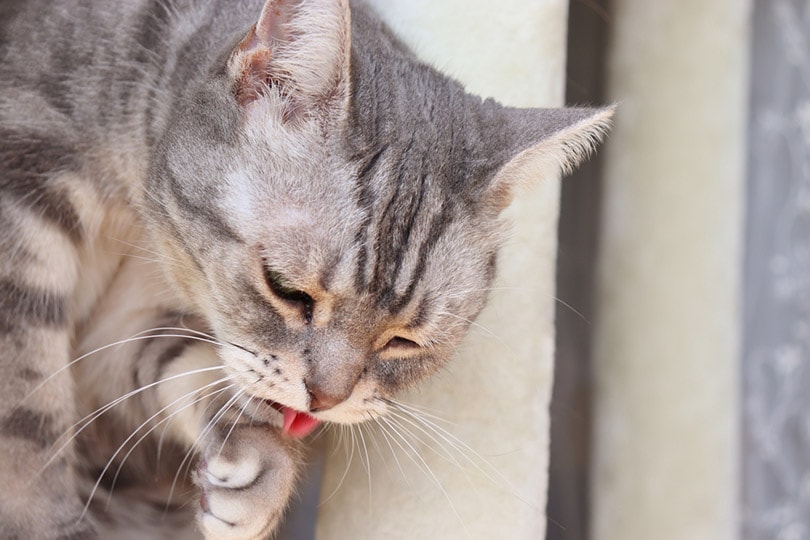VET APPROVED

The information is current and up-to-date in accordance with the latest veterinarian research.
Learn more »Click to Skip Ahead
The Scottish Fold is a controversial breed with a somewhat painful history. That’s because the cute, folded ears the cats are known for are also associated with a dreadful condition called osteochondrodysplasia. This degenerative disease affecting bones, cartilage, and connective tissues causes Scottish Folds a varying degree of pain and discomfort. This is why many reputable veterinary organizations worldwide, such as iCatCare, British Veterinary Association, Fédération Internationale Féline (FIF), and the Governing Council of the Cat Fancy in the UK, discourage breeding Scottish Folds due to serious ethical and welfare concerns.
Depending on their individual health and breeding, Scottish Folds may have an average lifespan of 14-16 years.

What’s the Average Lifespan of a Scottish Fold?
Based on many factors, mainly the genetic makeup and the degree of osteochondrodysplasia, alongside other potential health issues, some of which are inherited, Scottish Folds are believed to have an average lifespan of 14-16 years.1
Besides considering the serious ethical and welfare implications of breeding cats with lifelong health issues, knowing how to care for, feed, and nurture a Scottish Fold is essential. The more you know, the more it allows you to make an informed decision whether this breed of cat is for you, and how to ensure they live as pain-free as possible. It’s essential that you care for a Scottish Fold well and take them for annual checkups with your local vet if you want them to live a long, comfortable, and healthy life. Keeping such a breed is a great responsibility and should not be taken lightly.


The 8 Possible Reasons Why Some Scottish Folds Live Longer Than Others
As with all pets, many things may factor into how long a cat will live, most having to do with caring for their health and providing a safe, caring environment. Below, we’ll look at several factors that may influence your Scottish Fold’s lifespan.
1. Nutrition
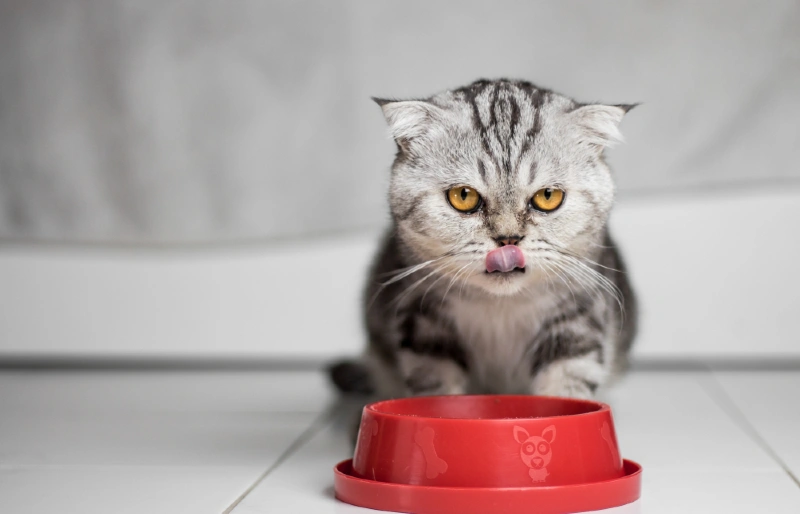
The best diet for a Scottish Fold cat is high in animal protein and has few if any, carbohydrates. Remember, felines are carnivores and don’t need plant-based food or food with carbs. They need protein from meat sources like turkey, fish, beef, and chicken. A high-quality diet should be balanced and complete and formulated according to the guidelines provided by the Association of American Feed Control Officials.
2. Environment and Conditions
Keeping their joint issues in mind, you should create a comfortable living space for your Scottish Fold that’s easy to access. It should give your pussycat many places to hide and relax that don’t force them to climb or jump too often, depending on the degree of their osteochondrodysplasia. Even the litter box you purchase can make a difference. The best boxes are lower on the side to make it easier for your cat to get in and out at potty time.
3. Size
The size of the average Scottish Fold male is about 12 pounds, while females weigh between 8 and 10 pounds on average. Remember that the heavier your Scottish Fold, the more weight is on their aching joints and, in some cases, the more pain they may experience.
4. Sex
Like most cats, female Scottish Folds may live slightly longer than males, according to research. Having your cat neutered or spayed will usually lengthen their lives by reducing roaming, fighting with other cats, disease transmission, the likelihood of outdoor accidents, and lowering the risk of certain health issues.
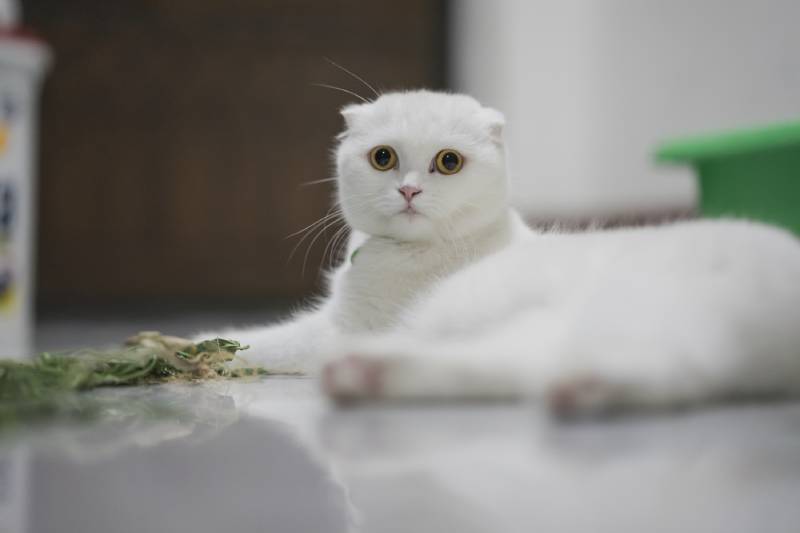
5. Genes
One of the factors you can’t control is the genes your Scottish Fold is born with. However, you can control who and where you adopt your Scottish Fold, which can make a huge difference in the cat you adopt. Responsible breeders know that breeding two Scottish Folds is often detrimental to the health of the offspring and unethical due to the risk of osteochondrodysplasia and other inherited health issues. You must find a reputable breeder when adopting your new kitten.
6. Breeding History
You must ask your chosen breeder, or the shelter where you find the cat, about the breeding history of your Scottish Fold. If they can’t tell you, you might want to keep looking.
7. Health Conditions
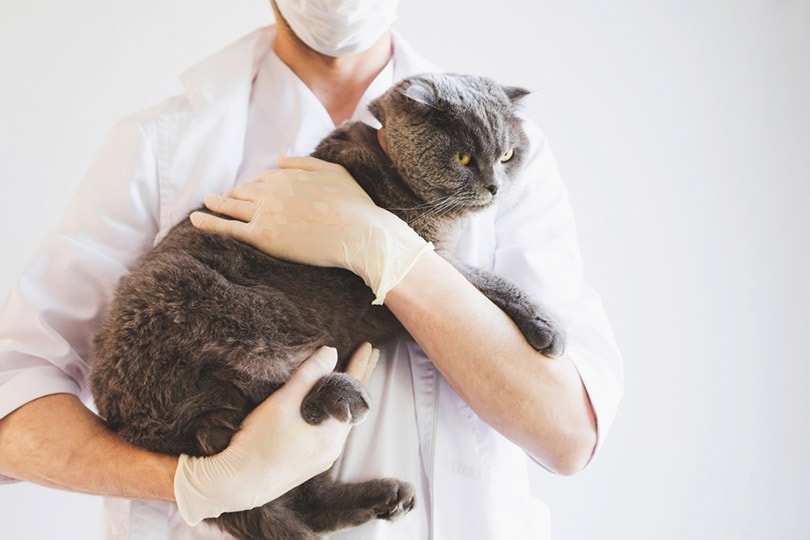
As mentioned, all Scottish Folds with bent ears suffer from a degenerative disease of their joints called osteochondrodysplasia, which affects each cat to a different degree. This condition affects the development of a Scottish Fold’s bones and cartilage, and it’s so concerning that, in the UK, the Scottish Fold isn’t even acknowledged by the Governing Council of the Cat Fancy for pedigree registration, while their breeding in Scotland requires a special license.
It’s also worth noting that if your cat develops osteochondrodysplasia, which all cats with bent ears have to a varying degree, they will need lifelong veterinary care to keep the pain under control.
8. Activity
Scottish Folds, depending on their health, may not be the most active cats, it’s true, and many are even less active than other cats due to their painful joint and cartilage issues. However, if yours is healthy and young, providing toys, cat trees, and other items to keep them active is vital.

The 6 Life Stages of a Scottish Fold
Interestingly, the Scottish Fold matures a bit faster than many other breeds, reaching maturity at about 8 to 12 months.
1. Kitten (0 to 18 months)
You might be surprised that a Scottish Fold kitten’s ears aren’t flat at birth. If your kitten has the folded ear trait, meaning they will develop osteochondrodysplasia, their ears will flatten at about 3 to 5 weeks. During this time, your kitten should receive their primary course of vaccinations, so make sure to schedule a visit with your vet.
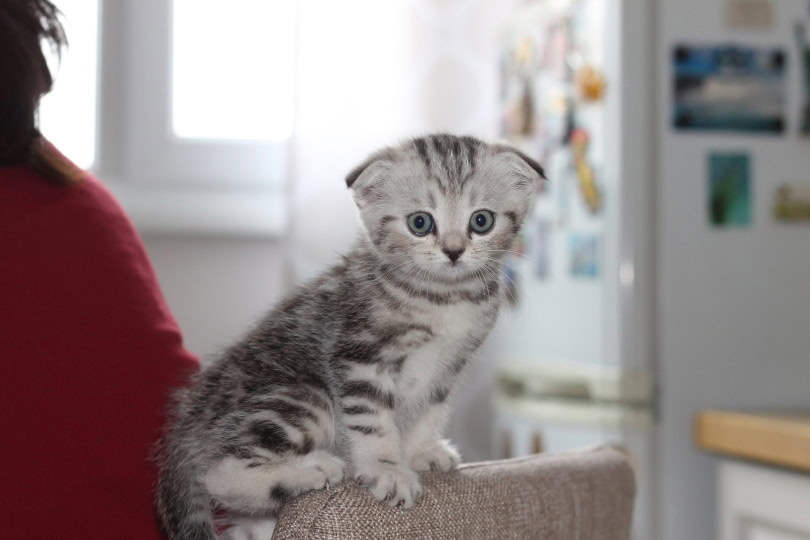
2. Junior (7 months to 2 years)
At this age, your kitten continues growing and developing until they reach their full size and mature. This is the time to speak to your vet about spaying or neutering your kitten.
3. Adult (3 to 6 years)
Adult Scottish Folds are medium-sized cats with rounded heads, big, round eyes, and thick, short coats. Yours might have flat ears, or they may not, depending on whether they inherited the trait for osteochondrodysplasia. While the folded ears make the cat so popular, a Scottish Fold with straight ears will have fewer health issues and live a longer, healthier life.
4. Mature 7 to 10 years)
As they are reaching their mature years, your Scottish Fold should have more frequent vet checks, at least every 6 months, to ensure they are in good health and as pain-free as possible. Unfortunately, around this age, a lot of cats develop common health issues such as kidney disease and an overactive thyroid.
5. Senior (11 to 14 years)
Preventing obesity in your senior Scottish Fold is critical, especially if they have mobility issues and pain due to osteochondrodysplasia. Overfeeding should be avoided at all costs, and their diet should be formulated for the needs of an older cat, especially considering any underlying health issues.
6. Super Senior (15 years plus)
At this age, your Scottish Fold is likely to slow down further. Keep up with frequent vet checks to make sure any health issues are picked up early and managed going forward.

How to Tell Your Scottish Fold’s Age
If you’ve adopted an adult Scottish Fold, determining their exact age might not be possible. However, there are a few things you can look at that will give you a good idea, including the following:
- An older Scottish Fold’s teeth will likely have more wear and tear
- When younger, a Scottish Fold’s eyes will be clear and bright. However, as they reach about 10 years old, their eyes may become cloudy. However, any cloudiness of the eyes should always be checked out by a vet, at any age, as it may indicate a more serious underlying health condition.
- An older Scottish Fold is more likely to groom themself much less frequently, especially if they’re suffering from joint pain.


Conclusion
While charming, friendly, and sweet, the Scottish Fold has suffered greatly due to their folded ears, and continues to do so. The ears hide a genetic secret that causes serious joint problems, which makes Scottish Folds suffer for their entire adult lives. Not all will be as severely affected, especially Scottish Folds with straight ears, but most will be.
Finding a reputable breeder is essential if you’re seeking a Scottish Fold with straight ears. This will lower the chance that your cat suffers from the dreaded osteochondrodysplasia and lives a longer, healthier, and happier life with less pain. Regular veterinary care and checkups are highly recommended. With prevention, good nutrition, and lots of TLC, your Scottish Fold should live a good life and make your life better and happier, too!
- Related Read: Is a Scottish Fold Hypoallergenic? Facts & FAQ
- Scottish Fold Cat Breed Health and Care | PetMD
- What are the animal welfare problems associated with Scottish Fold cats? – RSPCA Knowledgebase
- Scottish Fold cats | Help and Advice
- Scottish Fold osteochondrodysplasia – International Cat Care
- Scottish Fold | VCA Animal Hospitals
- Scottish Fold – The Cat Fanciers’ Association
- Scottish Fold Cat Breed – Facts and Personality Traits | Hill’s Pet
- Scottish Fold cats | Help and Advice
- Association between age, breed and sex in relation to urinary disorders in insured cats in Japan during fiscal year 2012 – PMC
- Life tables of annual life expectancy and risk factors for mortality in cats in the UK – Kendy Tzu-yun Teng, Dave C Brodbelt, David B Church, Dan G O’Neill, 2024
- The Scottish Fold: Temperament, Shedding, and Care | ASPCA Pet Insurance
- Cat care by life stage
Featured Image Credit: michasekdzi, Pixabay
